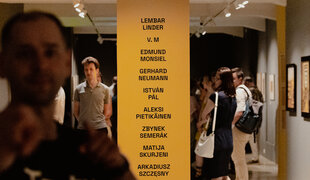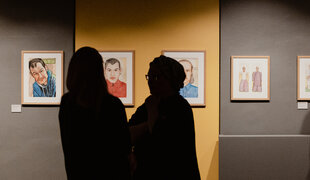-
Faculty of Arts and HumanitiesDean's Office, Faculty of Arts and HumanitiesJakobi 2, r 116-121 51005 Tartu linn, Tartu linn, Tartumaa EST0Institute of History and ArchaeologyJakobi 2 51005 Tartu linn, Tartu linn, Tartumaa EST0Institute of Estonian and General LinguisticsJakobi 2, IV korrus 51005 Tartu linn, Tartu linn, Tartumaa EST0Institute of Philosophy and SemioticsJakobi 2, III korrus, ruumid 302-337 51005 Tartu linn, Tartu linn, Tartumaa EST0Institute of Cultural ResearchÜlikooli 16 51003 Tartu linn, Tartu linn, Tartumaa EST0Institute of Foreign Languages and CulturesLossi 3 51003 Tartu linn, Tartu linn, Tartumaa EST0School of Theology and Religious StudiesÜlikooli 18 50090 Tartu linn, Tartu linn, Tartumaa EST0Viljandi Culture AcademyPosti 1 71004 Viljandi linn, Viljandimaa EST0Professors emeriti, Faculty of Arts and Humanities0Associate Professors emeriti, Faculty of Arts and Humanities0Faculty of Social SciencesDean's Office, Faculty of Social SciencesLossi 36 51003 Tartu linn, Tartu linn, Tartumaa EST0Institute of EducationJakobi 5 51005 Tartu linn, Tartu linn, Tartumaa EST0Johan Skytte Institute of Political StudiesLossi 36, ruum 301 51003 Tartu linn, Tartu linn, Tartumaa EST0School of Economics and Business AdministrationNarva mnt 18 51009 Tartu linn, Tartu linn, Tartumaa EST0Institute of PsychologyNäituse 2 50409 Tartu linn, Tartu linn, Tartumaa EST0School of LawNäituse 20 - 324 50409 Tartu linn, Tartu linn, Tartumaa EST0Institute of Social StudiesLossi 36 51003 Tartu linn, Tartu linn, Tartumaa EST0Narva CollegeRaekoja plats 2 20307 Narva linn, Ida-Virumaa EST0Pärnu CollegeRingi 35 80012 Pärnu linn, Pärnu linn, Pärnumaa EST0Professors emeriti, Faculty of Social Sciences0Associate Professors emeriti, Faculty of Social Sciences0Faculty of MedicineDean's Office, Faculty of MedicineRavila 19 50411 Tartu linn, Tartu linn, Tartumaa ESTInstitute of Biomedicine and Translational MedicineBiomeedikum, Ravila 19 50411 Tartu linn, Tartu linn, Tartumaa ESTInstitute of PharmacyNooruse 1 50411 Tartu linn, Tartu linn, Tartumaa ESTInstitute of DentistryL. Puusepa 1a 50406 Tartu linn, Tartu linn, Tartumaa ESTInstitute of Clinical MedicineL. Puusepa 8 50406 Tartu linn, Tartu linn, Tartumaa ESTInstitute of Family Medicine and Public HealthRavila 19 50411 Tartu linn, Tartu linn, Tartumaa ESTInstitute of Sport Sciences and PhysiotherapyUjula 4 51008 Tartu linn, Tartu linn, Tartumaa ESTProfessors emeriti, Faculty of Medicine0Associate Professors emeriti, Faculty of Medicine0Faculty of Science and TechnologyDean's Office, Faculty of Science and TechnologyVanemuise 46 - 208 51003 Tartu linn, Tartu linn, Tartumaa ESTInstitute of Computer ScienceNarva mnt 18 51009 Tartu linn, Tartu linn, Tartumaa ESTInstitute of GenomicsRiia 23b/2 51010 Tartu linn, Tartu linn, Tartumaa ESTEstonian Marine Institute0Institute of PhysicsInstitute of ChemistryRavila 14a 50411 Tartu linn, Tartu linn, Tartumaa EST0Institute of Mathematics and StatisticsNarva mnt 18 51009 Tartu linn, Tartu linn, Tartumaa EST0Institute of Molecular and Cell BiologyRiia 23, 23b - 134 51010 Tartu linn, Tartu linn, Tartumaa ESTTartu ObservatoryObservatooriumi 1 61602 Tõravere alevik, Nõo vald, Tartumaa EST0Institute of TechnologyNooruse 1 50411 Tartu linn, Tartu linn, Tartumaa ESTInstitute of Ecology and Earth SciencesJ. Liivi tn 2 50409 Tartu linn, Tartu linn, Tartumaa ESTProfessors emeriti, Faculty of Science and Technology0Associate Professors emeriti, Faculty of Science and Technology0Institute of BioengineeringArea of Academic SecretaryHuman Resources OfficeUppsala 6, Lossi 36 51003 Tartu linn, Tartu linn, Tartumaa EST0Area of Head of FinanceFinance Office0Area of Director of AdministrationInformation Technology Office0Administrative OfficeÜlikooli 18A (III korrus) 51005 Tartu linn, Tartu linn, Tartumaa EST0Estates Office0Marketing and Communication OfficeÜlikooli 18, ruumid 102, 104, 209, 210 50090 Tartu linn, Tartu linn, Tartumaa EST0Area of Vice Rector for Academic AffairsOffice of Academic Affairs0University of Tartu Youth AcademyUppsala 10 51003 Tartu linn, Tartu linn, Tartumaa EST0Student Union OfficeÜlikooli 18b 51005 Tartu linn, Tartu linn, Tartumaa EST0Centre for Learning and TeachingArea of Vice Rector for ResearchUniversity of Tartu LibraryW. Struve 1 50091 Tartu linn, Tartu linn, Tartumaa EST0Area of Vice Rector for DevelopmentCentre for Entrepreneurship and InnovationNarva mnt 18 51009 Tartu linn, Tartu linn, Tartumaa EST0University of Tartu Natural History Museum and Botanical GardenVanemuise 46 51003 Tartu linn, Tartu linn, Tartumaa EST0International Cooperation and Protocol Office0University of Tartu MuseumLossi 25 51003 Tartu linn, Tartu linn, Tartumaa EST0Area of RectorRector's Strategy OfficeInternal Audit Office
Hidden Worlds Expanding: Eastern European Outsider Art

The Kondas Centre exhibition ‘Hidden Worlds Expanding: Eastern European Outsider Art’ is set to open at the Tartu University Museum on 1 June.
The exhibition will showcase outsider art primarily from Eastern Europe, bringing together for the first time spectacular collections from a number of countries that have thus far been inaccessible to the general public. The exhibition will feature over 200 works by 59 artists from the historical and modern outsider art collections of 10 countries. Most of the works were borne of social isolation in psychiatric hospitals and special care homes, but pieces created as part of art therapy or supervised sessions in studios are also included.
"As the name implies, outsider art and artists stand outside mainstream art movements due to their nonconformist nature. At the same time, it’s noteworthy that this doesn’t lessen the value of the field, rather the opposite: uniqueness is one of art’s most highly prized qualities.”
Works of outsider art are often impossible to categorise under a specific style, define geographically or place in a specific era. However, they do possess a characteristic universality and deep sincerity, with no pretence to ambition. They can also be uncompromising: in some cases they serve as the only method of communication between their creator and the wider world. The ‘Hidden Worlds Expanding’ exhibition is to be held simultaneously in Viljandi, Tartu and Valga.
The Tartu University Museum will be showcasing the exhibition’s earliest historical works from the late 19th and early 20th centuries. Some originate from the university’s Psychiatry Clinic archives, but the majority are from the psychiatric art collection of the Hungarian Academy of Sciences and the collection of the Silesian Museum in Katowice. Well-known artists represented in the exhibition include Edmund Monsiel (1897-1962), a true classic of outsider art, and Pál István (1888-1944), who has been called the Hungarian Van Gogh. ‘Hidden Worlds Expanding’ forms part of the main programme of Tartu 2024 – European Capital of Culture.
The exhibition is accompanied by a catalogue and educational programme. The exhibition is being supported by Tartu 2024, the Estonian Ministry of Culture, the Cultural Endowment of Estonia, Viljandi City Government, the Liszt Institute in Tallinn, the embassy of the Federal Republic of Germany in Estonia, the embassy of Austria in Estonia and Kettuki RY.
Collections: Silesian Museum in Katowice (Poland); Kondas Centre (Estonia); Pavel Konečný’s private collection and the open studio collection of Masaryk University in Brno (Czech Republic); Art Brut Serbia collection (Serbia); the psychiatric art collection of the Hungarian Academy of Sciences (Hungary); Koprivnica City Museum (Croatia); Kettuki RY Hämeenlinna art studio (Finland); Art Cru gallery (Germany); and Lebenshilfe OÖ Gmunden open art studio (Austria).
Curators: Mari Vallikivi (The Kondas Centre) and Eva Laantee Reintamm (The Kondas Centre)
Design: Kärt Einasto
Communication: Annika Vihmann and Katre Ratassepp
Translations: Ann Kuslap
Editing: Tiina Sarv
Project Manager: Karoliina Kalda
Coordinator in Valga: Neeme Punder
Installation: Kaarel Narro, Indrek Grigor, Imre Toltsberg, Jüri Pillisner
Coordinator: Annabel Tanila
Getting there
- The exhibition is on the third floor of the museum, accessible by elevator.
- There is a high threshold at the door of the hall, and staff can provide a wooden ramp to help cross it.
Seating
- The exhibition hall has some chairs with backs that can be moved around the room freely.
- The hall has several benches without backs.
Read about the accessibility of the entire building here.
Hidden Worlds Expanding: Eastern European Outsider Art






